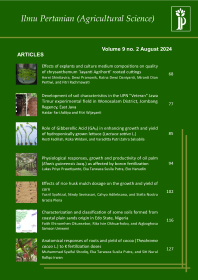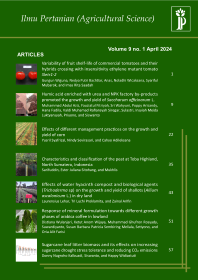
Amylose profile and rice grain morphology of selected F6 lines derived from a crossing of Black Rice and Mentik Wangi for the development of waxy pigmented rice
Eka Oktaviani(1*), Suprayogi Suprayogi(2), Zulfa Ulinnuha(3)
(1) Study Program of Agrotechnology, Faculty of Agriculture, Universitas Jenderal Soedirman Jl. Dr. Soeparno No 61, Purwokerto, Central Java 53123, Indonesia
(2) Study Program of Agrotechnology, Faculty of Agriculture, Universitas Jenderal Soedirman Jl. Dr. Soeparno No 61, Purwokerto, Central Java 53123, Indonesia
(3) Study Program of Agrotechnology, Faculty of Agriculture, Universitas Jenderal Soedirman Jl. Dr. Soeparno No 61, Purwokerto, Central Java 53123, Indonesia
(*) Corresponding Author
Abstract
Research on rice plant breeding to get superior black rice varieties with tender rice texture can be carried out by crossing Black Rice and Mentik Wangi variety. The rice lines derived from a crossing of these two varieties have recently reached the F6 line. The texture of rice is distinguished by the amylose content. The lower of the rice amylose, the more tender of the rice texture, and vice versa. This study aimed to find out the profile of amylose content and the grains morphology of the lines that will be developed as waxy pigmented rice. Analysis of amylose content was carried out using iodine-colorimetry methods. The quantification of amylose was measured based on the regression of the standard amylose curve. The results showed that all the F6 lines had the potential to be developed as waxy pigmented rice. Based on the Kruskall Wallis test, there was a variance in the amylose profile average of the eight genotypes. In terms of grains morphology, the line 482-17-7 and 482-17-18 had a combination colour between the two parents. In addition, there was a significant difference in grains size between the genotypes and the grain size of all lines were classified in the medium size. F6 lines resulted from the crossing between Black Rice and Mentik Wangi are recommended to be used as superior varieties of waxy pigmented rice.
Keywords
Full Text:
PDFReferences
Afza, H. (2016). The role of conservation and characterization of red rice germplasm in plant breeding. Journal of Agricultural Research and Development, 35(3), pp. 143-153.
Aliawati, G. (2003). Technique for analyzing amylose content in rice. Agricultural Engineering Bulletin, 8(2), pp. 82-84.
Avaro, M.R.A., Pan, Z., Yoshida, T., and Wada, Y. (2011). Two alternative methods to predict amylose content of rice grain by using tristimulus CIE lab values and developing a specific color board of starch-iodine complex solution. Plant Production Science, 14(2), pp. 164-168.
Bhattacharya, K. and Juliano, B. (1985). Rice: chemistry and technology. 2nd ed. St. Paul, MN: AACC, pp. 289–348.
Bhattacharya, M., Zee, S.Y., and Corke, H. (1999). Physicochemical properties related to quality of rice noodles. Cereal Chemistry, 76(16), pp. 81-86.
Chen, J. and Zhu, J. (1999). Genetic effects and genotype x environment interactions for cooking quality traits in indica-japonica crosses of rice (Oryza sativa L.). Euphytica, 10, pp. 9-15.
Dwiatmini, K. and Afza, H. (2018). Anthocyanin content characterization on pigmented local rice as genetic resources of functional food. Bul. Plasma Nutfah, 24(2), pp. 125–134 (Abstr.).
Goufo, P., and Trindade, H. (2014). Rice antioxidants: phenolic acids, flavonoids, anthocyanins, proanthocyanidins, tocopherols, tocotrienols, c-oryzanol, and phytic acid. Food Science & Nutrition, 2(2), pp. 75–104.
He, P., Li., S.G., Qian, Q., Ma, Q.Y., Li, J.Z., Wang, W.M., Chen, Y., and Zhu, L.H. (1999). Genetic analysis of rice grain quality. Theor. Appl. Genet., 98, pp. 502-508.
Heda, G.D. and Reddy, G.M. (1986). Studies on the inheritance of amylose content and Gelatinization temperature in rice. Genet. Agric., 40, pp. 1-8.
Indonesian Agency for Agricultural Research and Development. (2019). Jeliteng. [online]. Available at http://bbpadi.litbang.pertanian.go.id/index.php/varietas-padi/inbrida-padi-sawah-inpari/jeliteng. [Accessed 20 April 2021]
International Rice Research Institute. (2013). Standard evaluation system for rice. 5th ed. Los Banos, Philippines: International Rice Research Institute, pp. 55.
Juliano, B.O. (1971). A simplified assay for milled-rice amylose. Cereal Science Today,16(10), pp. 334-340.
Juliano, B.O., Luz, U.O., and Angelita, D.M. (1965). Relation of starch composition, protein content, and gelatinization temperature to cooking and eating qualities of milled rice. Food Technol., 19, pp. 1006.
Khumar, I. and Khush, G.S. (1986). Genetics of amylose content in rice (Oryza sativa L.). Journal of Genetics, 65(1-2), pp. 1-11.
Kim, B.G., Kim, J.H., Min, S.Y., Shin, K.H., Kim, J.H., Ryu, S.N., and Ahn, J.H. (2007). Anthocyanin content in rice related to expression levels of anthocyanin biosynthetic gene. J. Plant Biol., 50, pp. 156−160
Kim, C.K., Kikuchi, S., Hahn, J.H., Park, S.C., Kim, Y.H., and Lee, B.W. (2010). Computational identification of anthocyanin-specific transcription factors using a rice microarray and maximum boundary range algorithm. Evolutionary Bioinformatics, 6, pp. 133-141.
Kush, G.S. and Cruz, N.D. (2000). Rice grain quality evaluation procedures. In: R.K Singh, U.S Singh. & G.S Khush, eds., Aromatic Rices. 1st ed. New Delhi: Oxford and IBH Pub.Co.Pvt. Ltd., pp. 15-28.
Li, H., Prakash, S., Nicholson, T.M., Fitzgerald, M.A., and Gilbert, R.G. (2016). The importance of amylose and amylopectin fine structure for textural properties of cooked rice grains. Food Chem., 1(196), pp. 702–711.
Li, H., Prakash, S., Nicholson, T.M., Fitzgerald, M.A., and Gilbert, R.G. (2016). Instrumental measurement of cooked rice texture by dynamic rheological testing and its relation to the fine structure of rice starch. Carbohydr. Polym., 1(146), pp. 253-263.
Limtrakul, P., Semmarath, W., and Mapoung, S. (2019). Anthocyanins and proanthocyanidins in natural pigmented rice and their bioactivities. In: Venketeshwer Rao, Dennis Mans and Leticia Rao, eds., Phytochemicals in Human Health, 1st ed. London, UK.: IntechOpen, pp. 1-24.
Luna, P., Herawati, H., Widowati, S., and Prianto, A.B. (2015). Pengaruh kandungan amilosa terhadap karakteristik fisik dan organoleptik nasi instan (Effect of amylose content on physical and organoleptic characteristics of instant rice). Jurnal Penelitian Pascapanen Pertanian, 12(1), pp. 1-10.
Mardiah, Z., Rakhmi, A.T., Indrasari, S.D., and Kusbiantoro, B. (2016). Grain quality evaluation to determine consumer preferences pattern of rice in Java Islands. Penelitian Pertanian Tanaman Pangan, 35(3), pp. 163-180.
Ministry of Health Data and Information Center, Republic of Indonesia. (2015). The situation of cancer. In: R. Aprianda & Istiqomah (eds), Health Data and Information Window Bulletin. Jakarta: Ministry of Health Research and Development Agency, Republic of Indonesia, pp. 1-11.
Ministry of Health Republic of Indonesia. (2013). Basic health research. 1st ed. Jakarta: Ministry of Health Research and Development Agency, Republic of Indonesia, pp. 304.
Panesar, P.S. and Kaur, S. (2016). Rice: types and composition. In: B. Caballero, P.M. Finglas, and F. Toldra, eds., Encyclopedia of Food and Health. USA: Academic Press, pp. 646-652.
Pratiwi, R, Purwestri, Y.A., and Tunjung, W.A.S. (2013). Effect of diet rice pellets (Oryza sativa L.) 'Cempo Ireng', 'Cempo Abang', and 'IR-64' to lipid serum profile of white rat (Rattus norvegicus Berkenhout, 1769) hyperlipidemia. Proceeding of Seminar and Workshop on Nutrigenomic, Yogyakarta, Indonesia, pp. 12-18.
Pratiwi, R. and Purwestri, Y.A. (2017). Black rice as a functional food in Indonesia. Functional Foods in Health and Disease, 7(3), pp. 182-194.
Rahman, M.M., Lee, K.E., Lee, E.S., Matin, M.N., Lee, D.S., Yun, J.S., Kim, J.B., and Kang, S.G. (2013). The genetic constitutions of complementary genes Pp and Pb determine the purple color variation in pericarps with cyanidin-3-o-glucoside depositions in Black Rice. J. Plant Biol., 56, pp. 24-31.
Rohde, W., Becker, D., and Salamini, F. (1988). Structural analysis of the waxy locus from Hordeum vulgare. Nucl. Acids Res., 16(14B), pp. 7285-7186.
Roy, S.C. and Shil, P. (2020). Black rice developed through interspesific hybridization (O. sativa x O. rufipogon): Origin of Black Rice gene from Indian wild rice. bioRxiv, 423663, pp. 1-35.
Tan, Y.F., Li, J.X., Yu, S.B., Xing, Y.Z., and Xu, G.C. (1999). The three important traits for cooking and eating quality of rice grains are controlled by a single locus in a rice hybrid, Shanyou 63. Theor. Appl. Genet., 99, pp. 642-648.
Traore, K. (2005). Characterization of novel rice germplasm from West Africa and genetic marker associations with rice cooking quality. Dissertation. Texas A&M University
Um, M.Y., Ahn, J., and Ha, T.Y. (2013). Hypolipidaemic effects of cyanidin 3-glucoside rich extract from black rice through regulating hepatic lipogenic enzyme activities. J. Sci. Food Agric., 93(12), pp. 3126–3128.
Wang, K., Henry, R.J., and Gilbert, R.G. (2014). Causal relations among starch biosynthesis, structure, and properties. Springer Sci. Rev., 2, pp. 15–33.
Wang, Z.Y., Zheng, F.Q., Shen, G.Z., Gao, J.P., Snustad, D.P., Li, M.G., Zhang, J.L., and Hong, M.M. (1995). The amylose content in rice endosperm is related to the post-transcriptional regulation of the waxy gene. Plant J., 7(4), pp. 613-622.
World Health Organization. (2016). Diabetes: facts and figures. [online] Available at http://www.searo.who.int/indonesia/topics/8-whd2016-diabetes-facts-and-numbers- indonesian.pdf. [Accessed 20April 2021]
Yunus, A., Parjanto, Nandariyah, and Wulandari, S. (2018). Performance of Mentik Wangi rice (Oryza sativa, L.) M2 generation from Gamma Ray Irradiation. IOP Conf. Ser .: Earth Environ. Sci. 142, pp. 012050.
Zhang, J., Zhang, H., Botella, J.R., and Zhu, J-K. (2018). Generation of new glutinous rice by CRISPR/Cas9-targeted mutagenesis of the Waxy gene in elite rice varieties. J. Integr. Plant Biol., 60(5), pp. 369–375.
Article Metrics
Refbacks
- There are currently no refbacks.
Ilmu Pertanian (Agricultural Science) ISSN 0126-4214 (print), ISSN 2527-7162 (online) is published by Faculty of Agriculture Universitas Gadjah Mada collaboration with Perhimpunan Sarjana Pertanian Indonesia (PISPI) and licensed under a Creative Commons Attribution-ShareAlike 4.0 International License.














